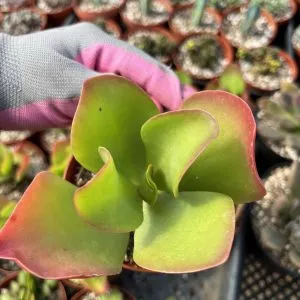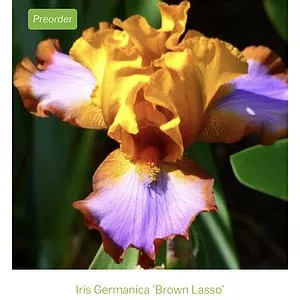No products in the cart.
Table of Contents
Many gardeners say orchids are fussy plants. Well, to some extent, it is true. Some species are cold-resistant, like the Calanthe orchid.
But don’t worry! With the Calanthe tips that we’ve prepared for you, you’ll gain enough insights on how to bring this exotic plant to your outdoor or indoor landscape.
Important Facts About Calanthe
Firstly, Calanthe is a Greek word meaning kalos (beautiful) and anthos (flower). The Calanthe orchid has two groups. You have the evergreen Calanthes and the deciduous Calanthe. These exotic groups bloom during summer while the other species can flower in fall.
Now, we break it down into two sub-genres according to their growth and flowering patterns.
Your evergreen orchid that botanists call Eucalanthe is a tropical plant with basal rosette-shaped leaves. You find the orchid blooming in fall and flowering in winter. The orchid is native to Asia, Africa, and Australasia.
The deciduous Calanthes that gardeners call the Preptanthe like the Calanthe vestita var and Calanthe rubens lose their leaves. Another exciting thing is that the first artificial orchid hybrid, Calanthe dominii was created in 1853.
Calanthe Care
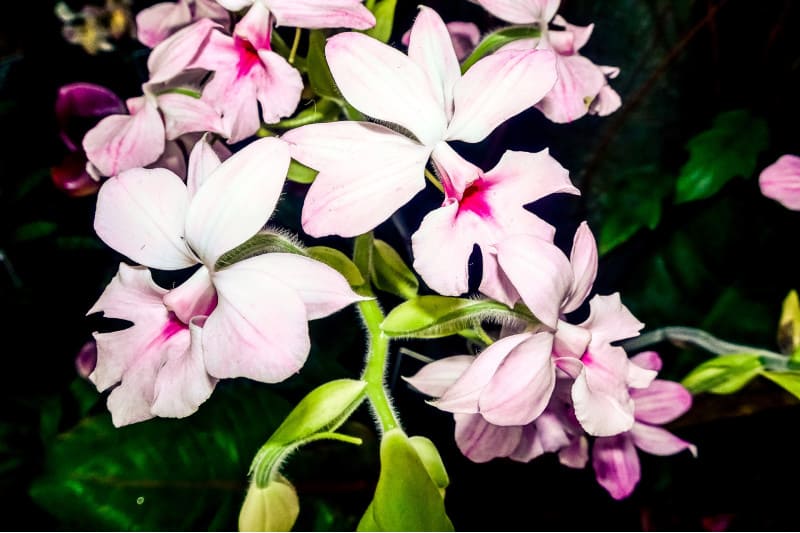
Many people also call the Calanthe orchid the Christmas orchid. One other fact we did not mention with the Preptanthe species is that it has individual pseudobulbs with inflorescences produced near the base.
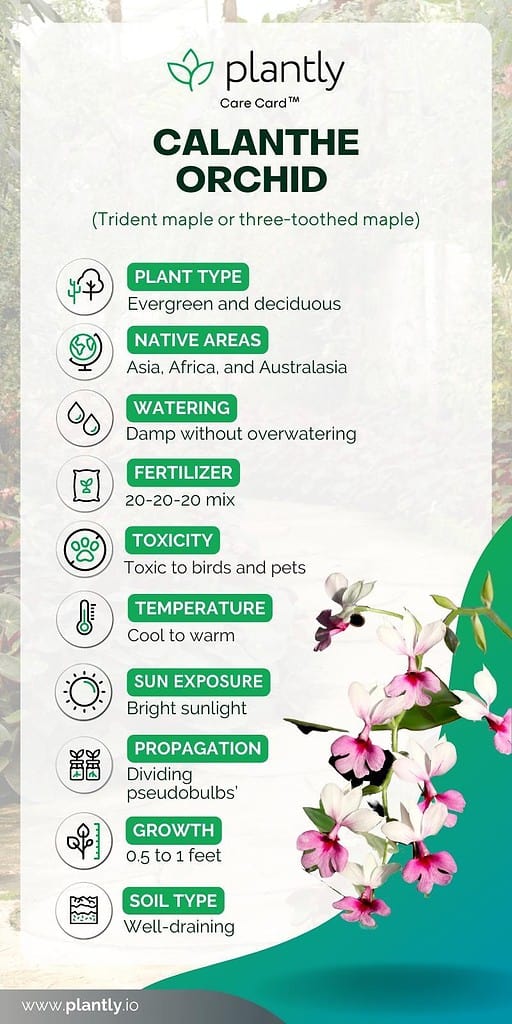
Best Potting Mix for Deciduous Calanthe
Whether grown outdoors year-round or as a houseplant indoors, the Calanthe genus has an aversion to the traditional potting media.
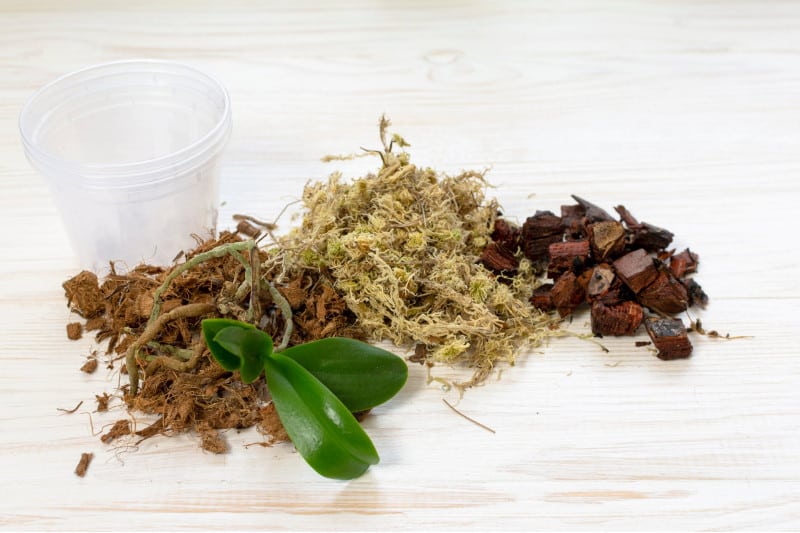
The orchids need special requirements with no sand or soil in the mixture. You can find a unique orchid potting medium to buy, but you can make one if you prefer.
Here is a superb formula you can follow: one part medium charcoal (optional), one part perlite or coconut husk chips, four parts fir bark, and one parch sphagnum moss chopped. Using this potting medium provides your orchids with well-draining ground that is great for not accumulating water at the pot’s base.
For added prevention, you can layer the bottom with pebbles.
Ideal Lighting for Calanthe
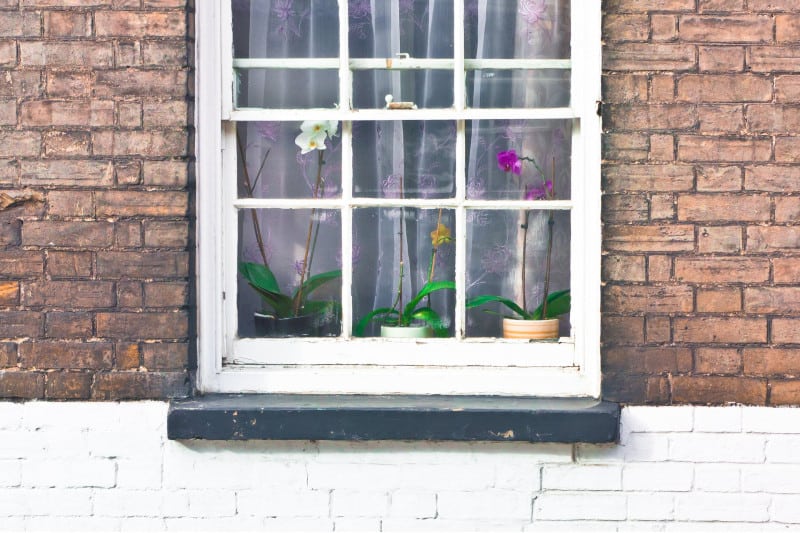
Calanthe orchid thrives best in bright indirect light. Place it in a south-facing window with light shade. You can use a lace curtain to serve as a barrier.
Too much light can result in faded leaves and burns with a display of brown spots. Most orchids can recover from a mild sunburn but such a condition will be fatal if left too long.
Calanthe orchids placed outside help to encourage flowering as the temperature changes between night and day. But please remember to place them in light shade. Do this gradually by leaving them outdoors for a longer period each day.
Watering Needs for New Growth
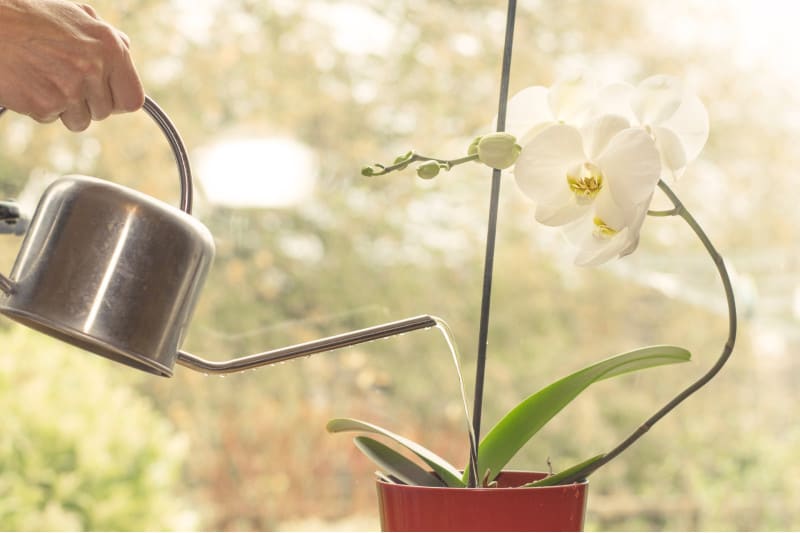
With most orchids, using the correct watering schedule helps. They prefer frequent watering in summer but you must reduce it a bit in winter.
Never let the ground get bone dry on normal days. The only times that this is allowed is when the orchids will be divided or repotted.
We recommend moistening them well using filtered water and leaving the ground to dry a bit. When the soil gets partially dried, your Calanthe orchids need watering again.
Remember that the excess water needs to drain out of the drainage holes.
Temperature & Humidity for Calanthe
Most orchids need a warm temperature throughout the day with cooler night temperatures. Thus, we recommend temperatures during the day between 75°F to 85°F (24-29 °C). The night temperatures can range between 50°F to 60°F (10-16°C). The difference in temperature helps develop new growths.
As soon as you notice the plants blossoming buds, you can leave them in a warmer place. But if it is scorching hot, the flowers do not last long.
The same applies to humidity. It needs to be high between 50% to 70% indoors. You may use a humidifier when the environment is dry.
Fertilizing for Healthy Roots
When grown as an indoor plant, it would help to provide good feeding using 20-20-20 fertilizer. Just dilute it to half or a quarter of the recommended dose. Then, when you see new growth in summer, you can fertilize once a week.
You only need to feed them every two weeks or once a month in the fall and winter. Avoid fertilizing when the potting medium is dry. You must water it first.
Propagating Orchid
Depending on the genus, you can propagate using the division of the pseudobulbs. These are found at the base of your plants. You will see that the tubers on the outside support the leaves while the middle ones are dormant.
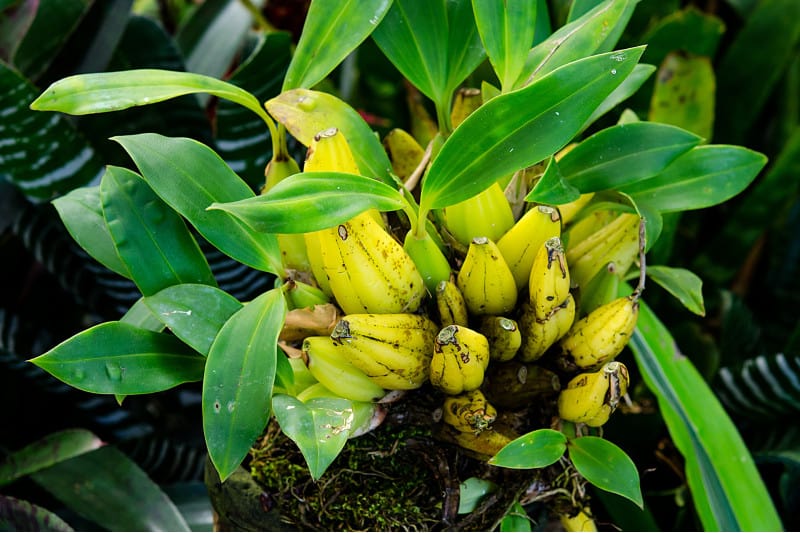
You can divide the tubers and plant them into different containers when the blossoms die in spring. To do this, you need to remove your orchid from the pot. Once you clear up the root cluster, use a knife to cut the tubers apart.
It’s best to start with the pseudobulbs with foliage and place them in up to four groups. Next, divide the back bulbs on the inner part without growth into separate bulbs. Then you can plant them in rich soil and water them a little bit for six weeks in a shady spot and moist.
Growth Zone
Calanthe orchids are hardy in the USDA zones seven and will survive winters in Zone 6b if treated as an outdoor plant.
In stock In stock In stock In stock
$12.00
Sold By:
Cacti and Exotica
Kalanchoe—Dragonfire hybrid
Rated 4.98 out of 5 based on 59 customer ratings00
Sold By:
Cacti and Exotica
$10.00
Sold By:
Smoot's Farm
Iris German Tall Bearded Brown Lasso Niswonger 1972 1 Dormant Rhizome
Rated 4.89 out of 5 based on 27 customer ratings00
Sold By:
Smoot's Farm
Free Shipping
$17.50
Sold By:
California Tropicals
Hoya Carnosa Krinkle Wax – 4” from California Tropicals
Only 49 available and it’s in 1 people’s basket Rated 4.96 out of 5 based on 25 customer ratings07
Sold By:
California Tropicals
Free Shipping
$39.99
Sold By:
Aloha Hawaii Orchids
$44.99Orchid Miltassia C.M. Fitch ‘Izumi’ Live Plant From Hawaii | Comes in a 4″ Pot
Rated 4.65 out of 5 based on 268 customer ratings00
Sold By:
Aloha Hawaii Orchids
Potting and Pruning
Orchids love filling up the pot, and you can wait until you see them bursting out of it about every two years.
The best time to transplant orchids is after the blossoms fade when you notice that there’s new growth. Such species as the Calanthe needs ample room for air circulation around the base, and investing in unique orchid pots help.
When repotting, check for old roots and remove them, but do not water them as soon as they are planted. Leave the orchid for a couple of weeks to recover from the shock. Then, you can gradually increase moisture.
Further, your plants will also benefit from pruning by cutting back the spikes when flowers die.
Calanthe Varieties
Calanthe sylvatica (Thouars) Lindl.
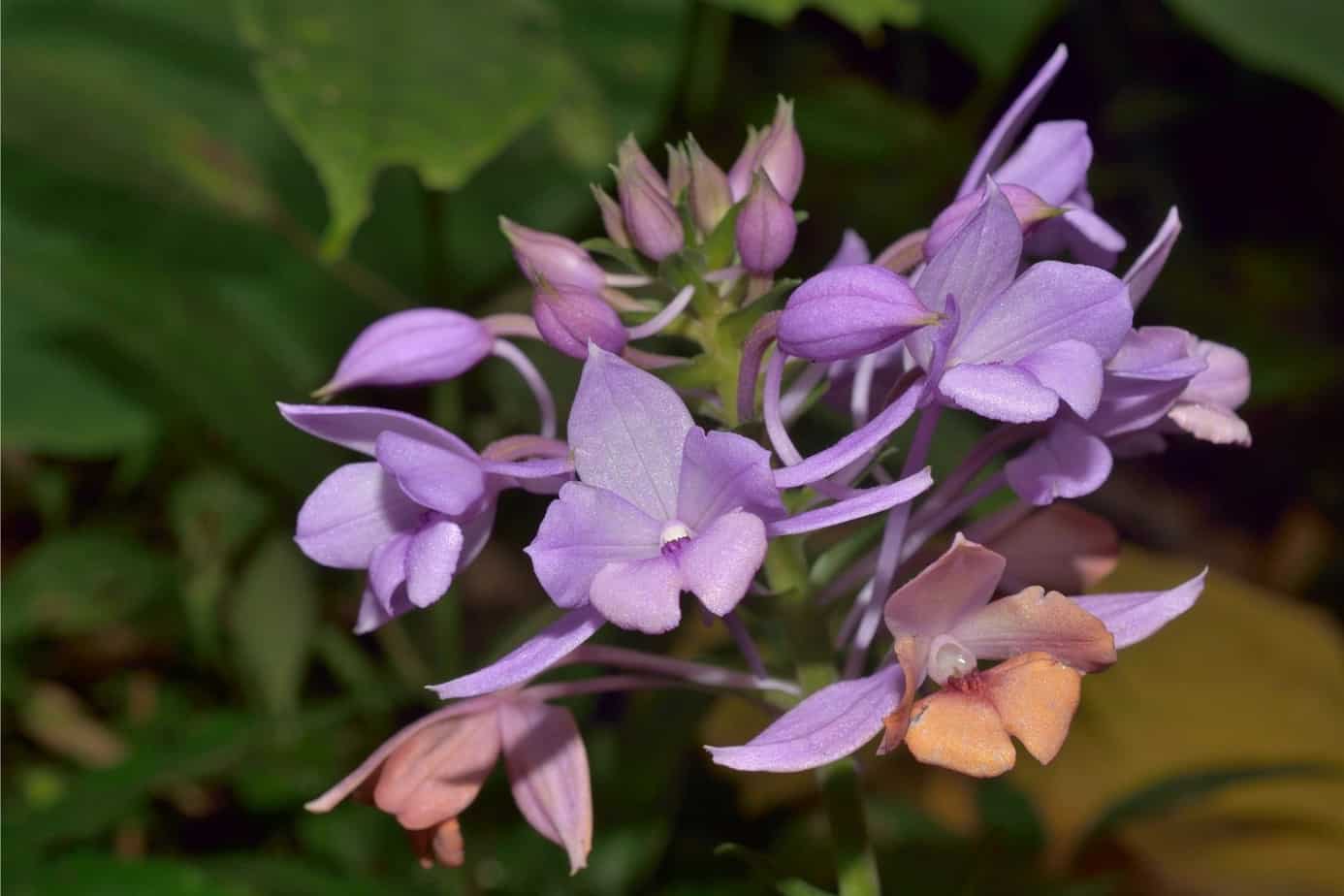
The orchid has huge blossoms but varies in size and pigmentation to shape. The blooms are white with violet lips or pink lips. Once the blooms age, it turns orange.
Calanthe rubens

When it comes to the growing media of this orchid, they thrive as terrestrial in cool regions. The pseudobulbs look flask shapes with reddish blooms.
Calanthe sieboldii

It is a spectacular species from Japan, producing pale yellow blossoms to bright lemons at times. You will spot the blossoms with brown lips and do not have an overpowering scent.
Calanthe Diseases & Pests
This outdoor plant is known to fall under attacks from insects and bacteria. Common pests are spider mites, aphids, and mealybugs. You can dip a paper towel or cotton in isopropyl alcohol to wipe them off. For aphids, use a diluted detergent solution. The other concern is root rot caused by overwatering.
Frequently Asked Questions
Discoloration can happen from too much or little water as it pulls moisture from the tubers. If orchids are dehydrated, the leaves look dull, soft, and rubbery. Even a change in light and temperature can lessen the color of the foliage.
You can keep the plants humid for blooming by dampening the top part of the potting media where the stems appear. But, never let the flowers get moisture as it results in spots.
You can get your orchid to rebloom with the following spike care steps:
- First, remove all the stems, and if it is green, you can cut the stake off about 1-inch above the first node below your lower bud.
- If you notice that the stem is brown, trim the flowers off at the base.
- If it has a double stem, remove one of them one inch above your first node below the lowest flower and remove the other stem at the base.
Calanthe orchid is not a rare species. You can easily get a hold of it when you visit your local garden stores. Or, you can browse through Plantly to find one in our collection.
Whether you want to buy, sell, or simply reach out to other plant enthusiasts, Plantly is the right place to be!
